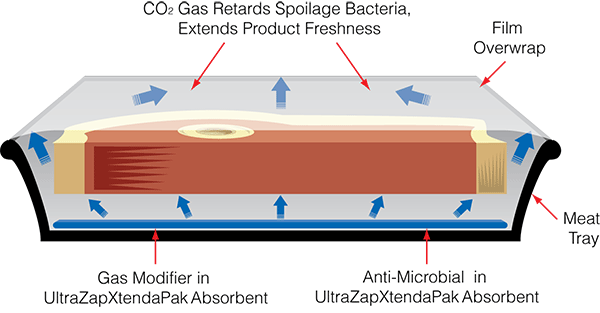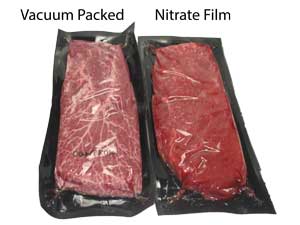| g e n u i n e i d e a s | ||||||
 |
 |
 |
 |
 |
 |
 |
| home | art and science |
writings | biography | food | inventions | search |
| MAP to the future | ||
|
||
|
May 2014 Summary- Modified Atmosphere Packaging
Converting sunlight to plant leaves to animal feed to muscle protein to ground meat to a hamburger, to be cooked on the backyard grill is energy intensive and inefficient. So when we enjoy meat, and we do, any steps we can take to eliminate waste is our responsibility. One step, already quietly adopted at the supermarket, is Modified Atmospheric Packaging (MAP). With all the usual trade-offs. Around 10% of supermarket meat is thrown out before purchase, and perhaps another 10% spoils before consumption at home. Often, the food is more than fit to consume- but its color has turned gray or spotty and we are picky eaters. Or we assume an "off" color indicates actual spoilage. In fact, as discussed in the "meat" tab, an off-color almost always reflects a low oxygen level of myoglobin in meat. Gray meat is merely oxygen deficient- still edible, and may redden when exposed to air. But meat also can spoil from bacterial contamination at the processing plant, or by the many hands between carcass and butcher case. So color remains a consumer trigger. A century ago, food arrived in open bins which attracted vermin and sticky fingers. Uneeda pioneered one of the first film packages- wax paper sealed, pre-proportioned "sanitary" crackers. No more filthy open barrels, no more soggy biscuits or waste.
A century later, almost 90% of meat in America is sold pre-butchered in "case ready" trays. Hard to imagine, but at one time buying chicken "parts" was, by itself, a great innovation like sliced bread! Sadly, if you want to buy "clod" or "double wide ribs", and they are not part of the standard inventory of case-ready trays in your region, good luck! It's the same problem at big-box hardware stores- low prices and quantity discounts, but if your faucet isn't recent and from one of the big three manufactures, or you just require a single washer, mail-order is your new best friend. Today, these packaging innovations are much more sophisticated, and include: Cryovac- meat vacuum-sealed in a thick, air tight bag at the factory. Invented after World War II alongside the revolution in plastic films, sealed bags reduce freezer burn and bacterial contamination. So increases shelf-life by at least a factor of two, and perhaps four. In some cases, the meat "wet ages" in the package, tenderizing on the supermarket shelf. The clear film allows the consumer to inspect the meat for fat content, and even probe for tenderness. All meat scraps at the factory are reused, so less waste throughout the production chain. But vacuum sealed bags have their downsides. The lack of oxygen turns meat dark purple, an unattractive color in many consumer's minds. It also reduces choice at the market- our supermarket's butchers simply stock its shelves with pre-cut meat. If you want anything other than the standard cut (e.g. point rather than the brisket flat, or clod), they may or may not be able to special order. And many stores silently use the cryovac bag as a freezer bag- too often I discover "fresh" tenderloin still frozen in the center. Modified Gas Packages- If consumers prefer their meat in the pink, one solution is to lay the meat on a tray, shrink wrap with impermeable plastic, and fill with oxygen. Instant "fresh" looking meat due to the formation of red oxymyoglobin. However, oxygen encourages bacterial growth, so typically MAP packages are injected with 80% oxygen and 20% CO2, which kills the most common bacteria (lower oxygen levels are used with poultry and some fish, as their red myoglobin levels are smaller). Shelf life of red meat might be be increased from around 2-4 days to between 5-8 days, while that of poultry is increased from 4-7 days to 16-21 days.
In addition to CO2 injection, the absorbent pad on the bottom of the package scavenges moisture, and chemically converts the water to additional CO2
Even at home, the chance of food spoiling is greatly reduce- IF you don't open the supermarket tray until ready to consume. Instead of oxygen, some MAP systems inject 0.4% of carbon monoxide. Yes, the same gas contributing to the smoke ring. CO displaces oxygen from myoglobin, turning meat almost neon pink. And, with no oxygen in the package, the meat lasts longer. The USDA agreed in 2002 to allow CO in meat packaging, concluding it was a "color fixative" rather than a "color additive", which required more scrutiny. They also relied on twenty years of successful implementation of CO MAP in Norway, which pioneered the original techncology3. Some consumer advocates worried the virtually permanent pink color might deceive consumers into thinking old meat was fresh, but careful package date labeling has allayed most of these concerns. Also, the 0.4% level was chosen partly because the absorbed CO will mostly dissipate during cooking or after a few days of open storage in the fridge. While not in widespread production, high carbon monoxide "soaks" are also effective. The meat is exposed to 5% CO for a day, which pinks the surface. It is then vacuum packed and refrigerated- the high affinity of myoglobin for CO, combined with the lack of competing oxygen, maintains the pink color for weeks. CO-MAP packages extend shelf-life to over a month- similar to vacuum packaging. There is also some evidence that longer shelf-life allows meat to tenderize in the package, as naturally occurring enzymes have more time to act. However, modified atmosphere packages can play havoc with our senses. In a few cases, well-done meat will look pink, in other cases medium rare appears gray. If you rely on color to determine doneness, or to impress you guests with your prowess as a short-order cook, a thermometer and lots of melted cheese may be your new best friend. Nitrite Films- Nitrite curing salts turn gray pork legs into pink ham. So food and packaging scientists have invented a way to incorporate minuscule quantities of sodium nitrite into the clear packaging film. Shrink wrapped over the meat, wherever it touches the surface, nitric oxide is produced by enzymatic action and turns the immediate surface red. So a nitrite films offers all the advantages of vacuum packing, without the purple color downside. However, in a black/clear package as seen below, when the package is opened the back of the meat may be gray or at least a different color of pink, if the black film does not contain nitrites.
Today, MAP technology is ubiquitous. Meat lasts longer, is more sanitary and looks better. We couldn't feed a growing population with as much protein without the mass industrialization of the food chain. But, MAP technology is also dis-intermediating the local butcher, reducing variety and paving the way for a meat monoculture. Perhaps we have no alternative, given demographic and economic trends. But it is always best to make informed choices, while choices still exist.
|
||
|
1 It is estimated that meat production consumes around 30% of water in the US, and nearly 40% of the arable land world wide. With global meat consumption rates rising (including fish in the animal protein category), the industry will have to innovate to grow. This inevitably means changes to the entire food production chain, where logistics will triumph over taste and choice, and "farm-to-table" is a luxury. 2 Perhaps 40% of their veggies go to waste- even here, MAP packaging such as pre-washed, pre-sorted salad greens is making a difference. Some researchers believe longer lived, convenient packaging will increase vegetable consumption as well. 3 The 0.4% level was chosen partly because it is low enough that it does not mask spoilage odors. Norway stopped using CO MAP in 2004 due to trade restrictions with the EU, where CO MAP is banned. Canada allows CO MAP in bulk meat packaging, but not for direct sale to consumers.
|
||
Contact Greg Blonder by email here - Modified Genuine Ideas, LLC. |



